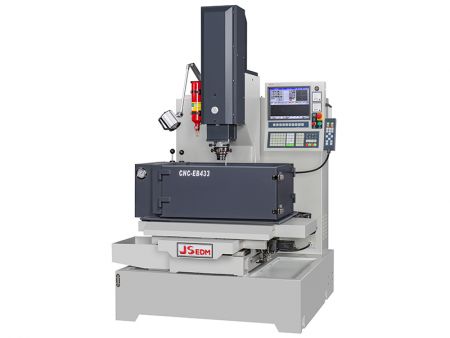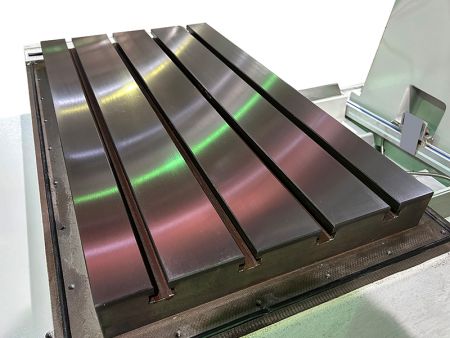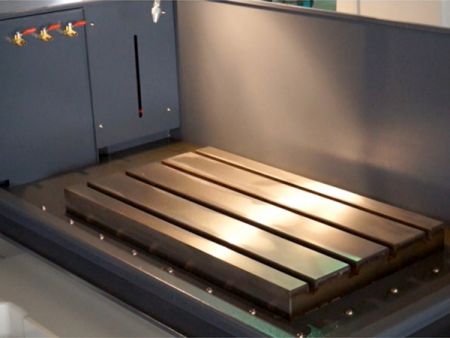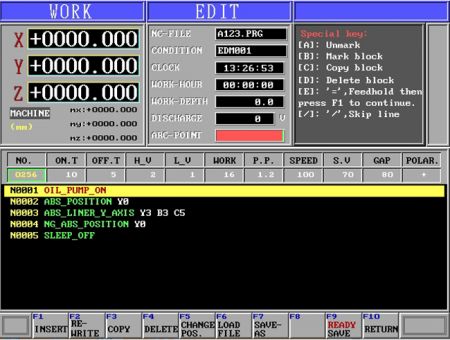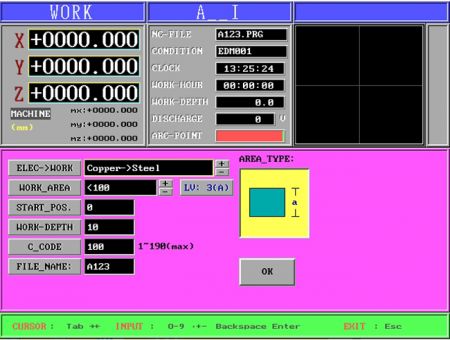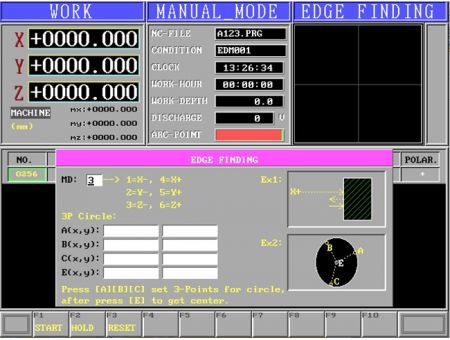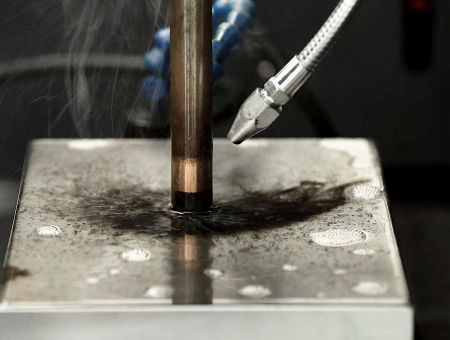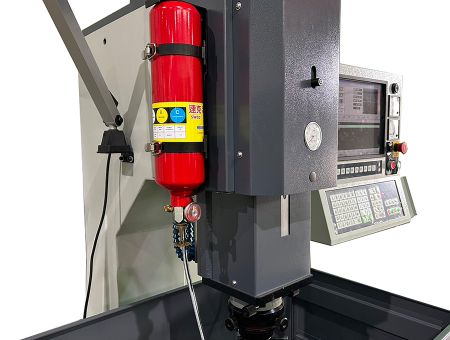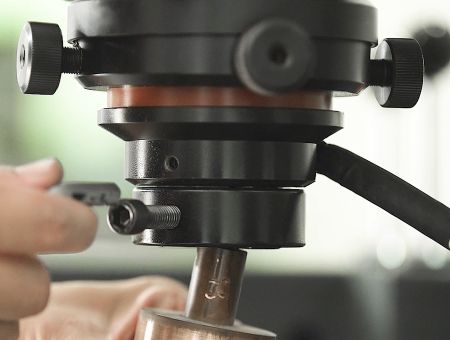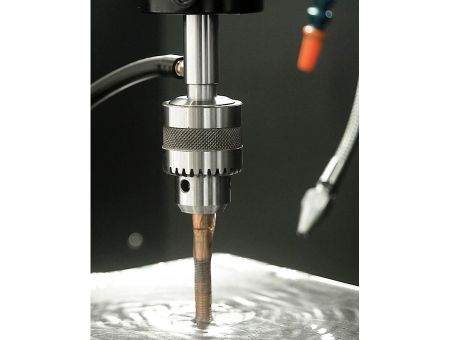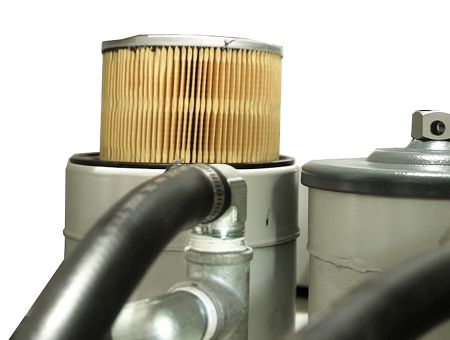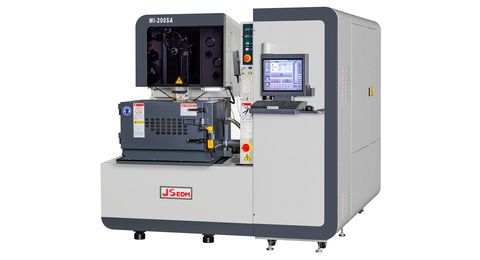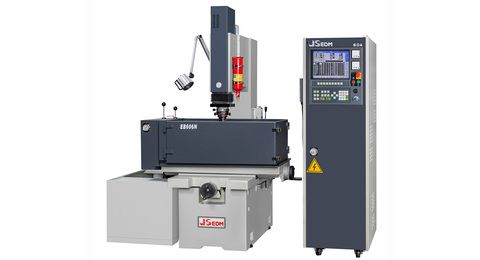JSEDM EB433: High-Precision Moving Table CNC EDM Machine for Mold Manufacturing
JSEDM's EB433 Moving Table-Type CNC EDM features 400/300/300mm XYZ travel, 1μm precision optical scales, and optional C-axis with ATC for high-efficiency automated machining. This compact 3-in-1 design delivers superior precision for plastic molds, automotive parts, and complex precision components with minimal electrode wear.
Moving Table-Type CNC EDM XYZ Travel 400 / 300 / 300
CNC-EB433
Moving Table-Type CNC Electrical Discharge Machine
The EB433 features a 3-in-1 structure, integrating the oil tank, main body, and electrical cabinet into a single unit, significantly reducing the footprint and thereby increasing the volumetric efficiency within the customer's facility. Although the base is designed as an oil tank, JSEDM utilized 3D simulation technology to analyze the deformation under load and implemented structural reinforcements based on the results to prevent deformation from affecting machining accuracy.
To ensure more stable positioning accuracy during machining, the EB433 is equipped with 1μm optical scales on all three axis, ensuring precision throughout the machining process. For added ease of operation and to enhance machining accuracy, the EB433's screen is positioned on the right side of the Z-axis and is equipped with a swivel arm, allowing operators to more conveniently align molds and adjust parameters based on machining conditions.
Additionally, the EB433 can be optionally equipped with a C-axis and ATC (Automatic Tool Changer) to achieve high-efficiency automated machining.
In summary, the EB433 is a powerful, highly precise, and user-friendly CNC EDM machine, ideal for various precision machining needs, making it an excellent choice in industrial manufacturing.
Machine Introduction
The EB433 is a high-precision CNC EDM machine that utilizes precision-grade ball screws and linear guides in its components, ensuring accuracy in both orbit and vector machining. It is also equipped with Delta's AC servo motors, providing reliable power support.
The machine's specifications include an XYZ axis travel of 400 / 300 / 300mm and a table size of 600 x 350mm, making it suitable for processing medium to small-sized workpieces.
Here are three application examples of the EB433:
- Bottle Caps: The internal spiral structure requires CNC jogging functionality for machining, while the external anti-slip patterns also need EDM processing. The EB433, with its high-precision machining capabilities, can effectively produce complex internal and external structures, ensuring the quality and functionality of the bottle caps.
- Screw Thread Repair: When the thread holes in a mold are damaged or worn, they need to be repaired. The EB433 can perform precise thread repairs using its XY, YZ, and XZ jogging functions, allowing accurate repairs regardless of whether the thread hole is located on the top or the side.
- Seatbelt Components: The internal parts of a seatbelt assembly often have complex shapes and structures that require precision machining. The EB433's side-placement feature allows operators to easily perform machining, ensuring the accuracy and integrity of the internal components.
High-Rigidity Structure:
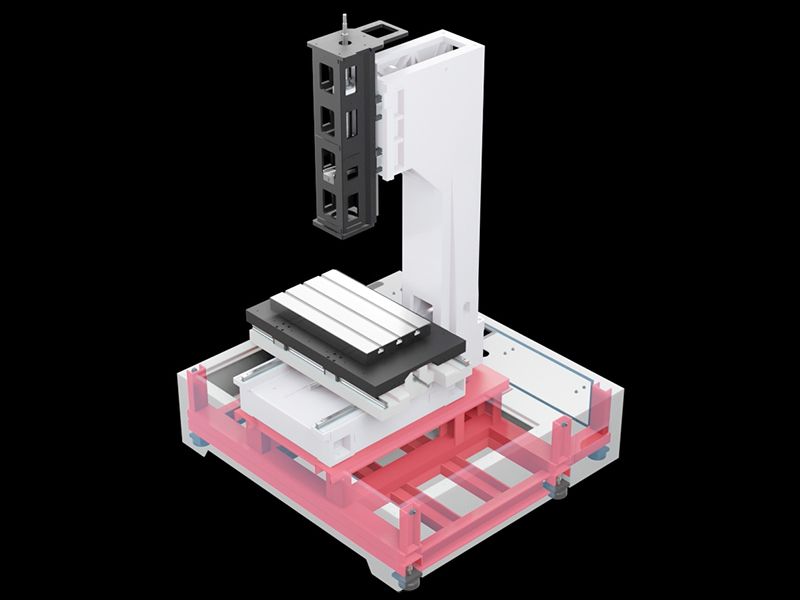
- The machine body structure utilizes CAE (Computer-Aided Engineering) to simulate structural analysis of each axis during actual operation. Therefore, we have adopted a high-rigidity T-shaped body structure to reduce load and thermal deformation issues, ensuring long-term precision of the machine.
- Made from Meehanite cast iron and stress-relieved through heat treatment, the structure features a high-rigidity, symmetrically balanced design, which helps reduce load and thermal deformation.
XYZ-Axis Travel Structure:
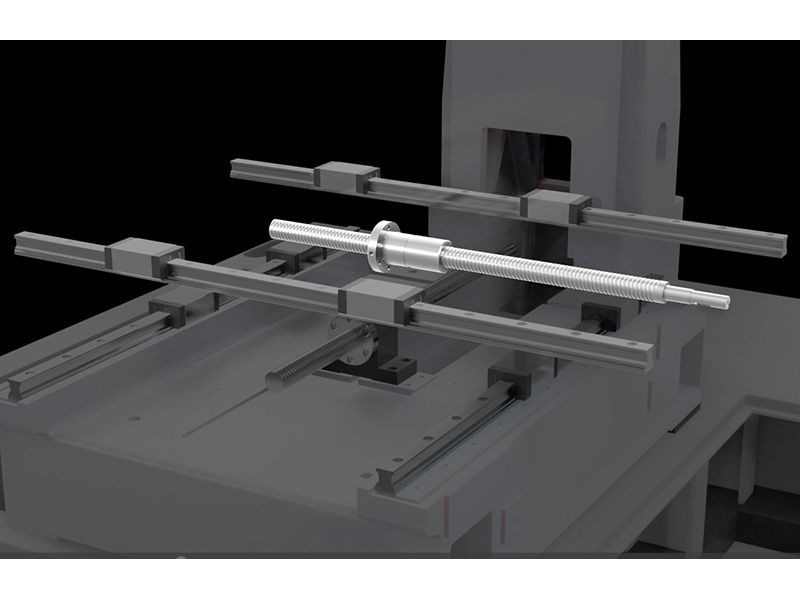
- The X, Y, and Z axis use low-friction linear guides and ball screws, ensuring precision even under heavy loads while allowing for agile operation during machining. This design guarantees both accuracy and flexibility throughout the machining process. Additionally, the wide span of the linear guides ensures that the parallelism of the worktable remains unaffected during movement in any direction under load, thereby ensuring machining quality and stability.
- A belt-driven servo system is employed to reduce the size of the machine. By utilizing gear ratio, even a low-wattage servo motor can drive the entire machine, meeting energy-saving requirements. This design not only enhances the machine's operational efficiency but also reduces energy consumption, aligning with environmental and energy-saving goals.
Features and Applications of the C-axis:
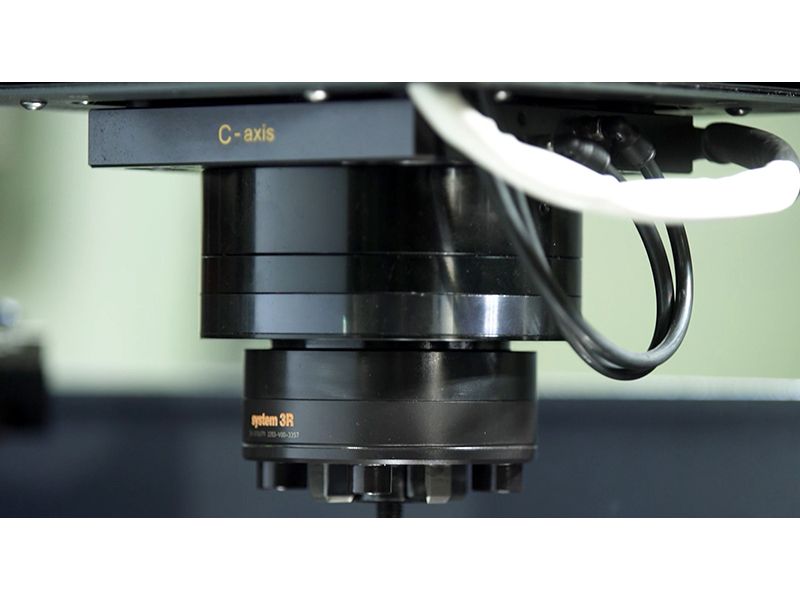
- The C-axis features high-precision positioning capabilities, enabling accurate positioning and rotation of parts during machining. This allows for more precise machining and better results, especially when processing parts that require rotational machining.
- The C-axis can achieve indexed machining, allowing parts to be machined at fixed angles. This function is particularly useful for parts that require periodic or repetitive machining, significantly improving consistency and efficiency.
- For parts with complex thread structures, the C-axis can perform thread and complex shape machining. If the part has special-shaped threads that need to be machined at different angles, the rotational capability of the C-axis can precisely achieve the required shapes.
Automatic Tool Changer (ATC) and the Advantages of Automation:
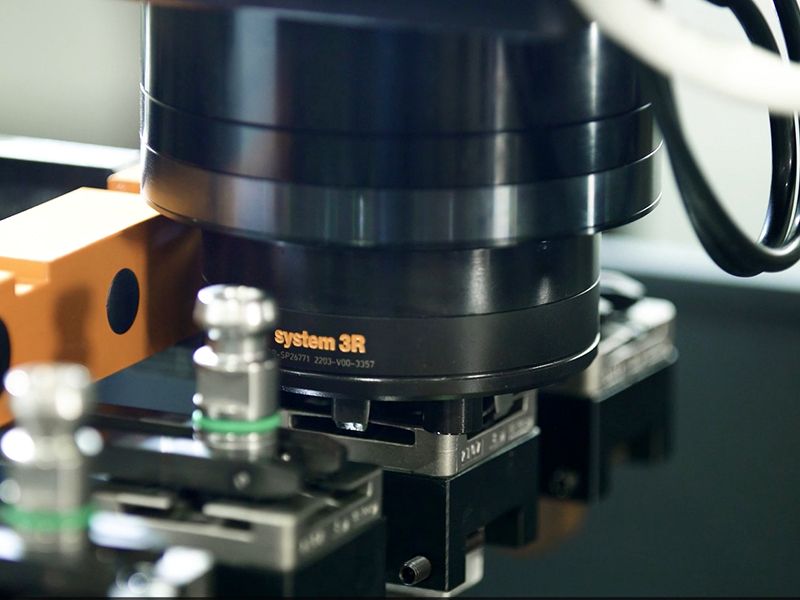
- Allows quick and precise tool changes, reduces tool change time and thereby increasing machining efficiency.
- Ensure that it is precise in every tool change, avoiding errors caused by human factors, which in turn improves machining accuracy.
- Can automatically complete tool changes during the machining process, reducing downtime and increasing machine uptime.
- Minimizes the need for manual intervention, reducing labor requirements while also lowering the risk of errors and accidents caused by human operation.
Controller Performance and Features
● Automatic Indexing: The system allows users to directly select material type and area, input machining depth and starting height, and then automatically search for the optimal conditions to generate the machining program. Users can also edit and save the generated program, which can be reloaded for future use without altering the original database content.
● High-Efficiency Discharge Module: The discharge circuit uses MOSFET transistors and a fast discharge device (POWER SINK) to enhance machining efficiency and reduce electrode wear. The machining circuit employs FPGA IC components for faster monitoring of discharge conditions (up to single discharge waveform monitoring), providing more effective prevention of carbon buildup (ARC). Users can set ARC voltage levels, ARC time, and ARC sensitivity to further improve machining efficiency. Additionally, it offers two-stage gap and two-stage off-time functions to assist users in automatically adjusting machining parameters when ARC occurs, leading to better machining efficiency. These features and designs aim to improve machining efficiency, reduce wear, and provide better operability and stability.
● Servo Control: The servo control system uses DSP digital processing, allowing for faster response times, with loop control occurring every 0.2ms, which is faster than the typical 1ms or more response time of PC-based controllers. This characteristic enhances spindle stability during machining, ensuring smoother machine operation.
Additionally, the CNC EDM machine offers a multi-stage debris removal mode, suitable for deep hole machining and thin sheet processing, providing more flexible machining options.
Moreover, the servo protection function is an important feature that prevents electrode damage caused by improper user operation, such as mold crushing. This protection function ensures the safety and longevity of the electrode during the machining process.
These combined features make the CNC EDM machine's servo control more flexible, stable, and safe, capable of meeting various machining demands while ensuring high-quality machining results.
Product Specification
| Technical Spec. | |||
|---|---|---|---|
| Mechanical Structure | Moving Table | Distance Between Platen to Table | 610mm |
| Work Tank Capacity L x W x H (mm) | 900 x 520 x 385mm | Optical Scale Display | 1um |
| Work Table Size | 600 x 350mm | Max. Machining Current | 60A |
| X Axis Travel (Right-Left) | 400mm | ||
| Y Axis Travel (Front-Back) | 300mm | Min. Electrode Wear Ratio | 0.12% |
| Z Axis Travel | 300mm | Machine Weight | 1750kgs |
| Max. Workpiece Weight | 500kgs | Fluid Tank Capacity | 300L |
| Max. Electrode Weight | 100kgs | Machine Outside Dimensions (W x D x H) | 1700 x 1600 x 2450mm |
- Gallery
- In this interface, you can input various machining programs such as vector machining, orbiting, side placement, and rectangular processing.
- The AI automatic indexing function allows users to directly select the material and area to be machined. After inputting the machining depth and starting height, the system automatically searches for the optimal conditions.
- The one-page multifunctional calibration includes edge finding, inner hole finding, outer circle finding, vertex finding, and circle center finding.
- When the fire sensor detects flames, it sends an alarm signal and pauses the machine to prevent a fire from occurring.
- When the worktable catches fire due to excessive oil temperature, the fire extinguisher is activated to extinguish the fire, providing a second layer of protection beyond the fire sensor.
- The adjustable electrode head allows for quick electrode replacement and adjustments for parallelism and verticality.
- The three-jaw chuck allows dielectric fluid to pass directly through the jaws and flow along the electrode into the mold, enhancing debris removal efficiency.
- The vertical filter cartridge design makes it easy to replace the filter and prevents the filter from breaking during replacement, avoiding spills of oil and metal debris.
- Video
- Download
Why is the EB433's controller system and automation capability revolutionary for plastic mold production?
The EB433's advanced controller with AI automatic indexing and DSP digital processing (0.2ms response time) optimizes machining parameters instantly, while the optional C-axis and Automatic Tool Changer transform your production capabilities. This combination enables continuous unmanned operation for complex plastic molds with intricate features like bottle caps with internal spirals or textured surfaces. Our clients have achieved up to 40% reduction in setup time and 25% increase in overall production capacity while maintaining superior surface finish and dimensional accuracy.
Designed specifically for high-precision applications, the EB433 excels in machining small to medium-sized plastic molds, automotive components, and complex precision parts. The user-friendly interface features AI automatic indexing that optimizes machining parameters based on material type and area, while the high-efficiency MOSFET discharge module with FPGA IC components ensures superior surface finish with minimal electrode wear (as low as 0.12%). Optional features include a high-precision C-axis for indexed machining and an Automatic Tool Changer (ATC) system that significantly enhances production efficiency by reducing downtime and human intervention. With comprehensive safety features including fire sensors and automatic extinguishers, the EB433 represents an ideal balance of precision, efficiency, and operational safety for modern manufacturing environments.

